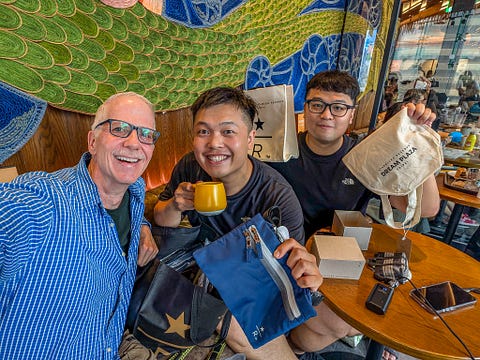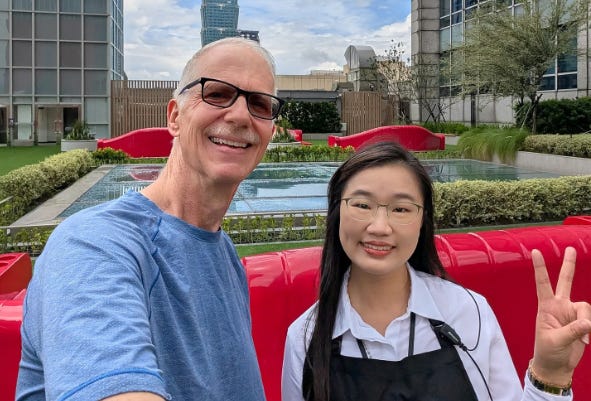You Can Tell a Lot About a Country From Its Starbucks
- Brent and Michael Are Going Places <brentandmichaelaregoingplaces@substack.com>
- Hidden Recipient <hidden@emailshot.io>
You Can Tell a Lot About a Country From Its StarbucksThe stores in this coffee chain say something positive about Asia. But they also provide more evidence of America's decline.When Starbucks Coffee became an expanding chain in the 1980s, their coffee houses were intended to be cozy, inviting places where people would gather. In 1989, the sociologist Ray Oldenburg described businesses such as this as a “third place” — the “first place” being a person’s home, and the “second place” being where they work. The third place is where an individual socializes: a church, a library, a corner bar like in Cheers — or a coffee shop like Starbucks. By the late 90s, Starbucks was even using the “third place” terminology in their branding, openly boasting that they were exactly such places, with warm lighting, and welcoming architecture and atmosphere. This is where I entered the picture. In the 90s, living in Seattle — the birthplace of Starbucks — I felt a bit of local pride in the rising success of the chain. But I also simply enjoyed the stores, which were great places to meet friends or to sit and read. The baristas were friendly, and, yeah, I also liked the coffee. I wasn’t alone. The stores were usually packed.
But brands change — usually, because the country in which they’re located changes first. In America, nearly 75% of all Starbucks’ transactions now happen through drive-thrus, via mobile orders, or delivery services like Uber Eats. Starbucks is also now a ubiquitous presence in grocery stores like Safeway and retail stores like Target — a far cry from the welcoming “third spaces” of yesteryear. The last time I was back home in Seattle, I stopped into a downtown Starbucks. Most of the store’s seating had been removed — perhaps a lingering casualty of COVID or maybe to discourage homeless people. There were plenty of people, with the baristas frantically working to fill their orders. But the customers would arrive, find their coffee on the counter, and then leave without exchanging a single word with another human being. The store had all the warmth of a Seattle bus stop on a wet January morning. A homeless man did enter — obviously mentally ill — and he swore at the customers and stole someone else’s coffee off the counter. Finally, a barista arrived and said, “Come on, Frank, you gotta go.” On the Cheers TV show back in the 90s, everyone famously knew your name. Here, no one knew anyone’s name, except the mentally ill homeless person that the baristas had to repeatedly kick out onto the street. Which might be a pretty good reflection of America’s increasingly on-the-go, car-centric, isolated lifestyle. Nearly half of Americans no longer have a “third place” — up from 33% only six years ago. You might say, “It’s all COVID.” But Asia took COVID far more seriously than America, and their Starbucks are already back to being vibrant, welcoming places. I know this for a fact after recently visiting stores in Thailand, South Korea, Malaysia, and Cambodia. And post-COVID, I also saw the same thing in Turkey, Italy, and Mexico. As usual, America is the massive outlier. Before you excoriate me for patronizing Starbucks, please note that as we travel, I also visit local coffee shops. But as a nomad, Starbucks is a great place to work thanks to decent chairs and reliable WiFi. And I’m lactose intolerant, and I can count on Starbucks to have milk alternatives and to get that important part of my order right — something not always true at local coffee shops in countries where English isn’t widely spoken. I especially like the Starbucks in our current nomad location, Taipei. And the Taiwanese clearly love the company too. I recently visited the grand opening of a new “Starbucks Reserve” — a special, more upscale Starbucks store. It was so mobbed I couldn’t even get in the first time I tried. But at a nearby Starbucks, I met William, a young Taiwanese man who had just come from the event with a friend, and they were happy to show off their new “Starbucks” swag. (Many young Taiwanese proudly use Anglicized names.) “I first started going to Starbucks when I was in high school,” William told me. “It was one of my favorite places where I could study and relax. Now I go to Starbucks twice a week, sometimes to read and relax, or to catch up with my friends. I really enjoy the cozy environment.” Unprompted, William even specifically mentioned the idea of the “third place,” which may be even more important in crowded Asian countries where apartments — and all personal spaces — tend to be very small. Socializing, which seems to happen a lot, takes place in restaurants, shopping malls, street markets, and — yes — places like Starbucks. And here, Starbucks is trying hard to meet that particular need, creating the kinds of cozy, welcoming stores they used to build in America. William didn’t mention it, but here in Taiwan, Starbucks is also widely seen as being aspirational. The people who go there see themselves as successful, upwardly mobile, and sophisticated. In fact, another Taiwanese person told us, “Starbucks is expensive coffee. Often, when we go there and see that there are no seats, no place to sit down, we’ll go somewhere cheaper.” I’m writing this article at yet another Taipei Starbucks, and I’m surrounded by a multigenerational crowd: students, businesspeople, and folks well into their seventies — everyone mostly chatting with friends. I also see a mother with a baby and toddler, a young man with his grandparents, loads of students studying, and a businessman catching up on his sleep. It’s mind-boggling how at home everyone seems. I work here often, usually for hours at a time, and no one knows my name here either, but no one has ever asked me to leave. Incidentally, I did finally make it inside that new Starbucks Reserve, which is so popular it required reserving a time slot via a QR code. It was enormous. And it was completely packed on a weekday, more than a week after opening. And they’ve clearly tried to make it, yes, a center of the community, but also a destination in its own right. But if I said before that Starbucks in America might be a pretty good representation of the greater culture, the Starbucks here might provide an interesting window on the Taiwanese too. Like most Asian cultures, they obviously have very high “social trust.” And compared to America, they still place a much higher priority on socializing and community. But this being Taiwan, they’re also very Western-focused, aspiring to Western-style capitalism and the lifestyle that goes along with it. My advice? Be careful what you wish for. At that Starbucks Reserve store, I had a chance to talk to Melody Sung, a district manager. “Starbucks wants to create a place for people to come together in a special place to enjoy their coffee,” she said. “For many people in Asia, it’s also a ‘third place’ where they can relax and enjoy themselves.” Another person who brought up the concept unprompted! Sung, who has been with Starbucks for fourteen years, started visiting Starbucks when she was in junior high school and quickly became a fan. “The baristas were so kind and friendly and made me feel loved,” she said. I wouldn’t say I ever felt “loved” by the baristas back when we lived in Seattle. But they were always friendly, efficient, and even remembered my order. And there may be hope yet for Starbucks back in America. Revenue and in-store visits are declining, and Starbucks CEO Brian Niccol has responded by introducing their “Back to Starbucks” plan. The goal is to return the company to its roots as “a gathering space” where people “want to linger.” Americans don’t like what Starbucks has become — and perhaps what they have become. Who knows? Maybe there’s hope both can change. Michael Jensen is a novelist and editor. For a newsletter with more of my photos, visit me at www.MichaelJensen.com.
Using the above affiliate links will cost you nothing and help support our newsletter. You can also support us with a one-time donation of any amount here: |
Similar newsletters
There are other similar shared emails that you might be interested in:






